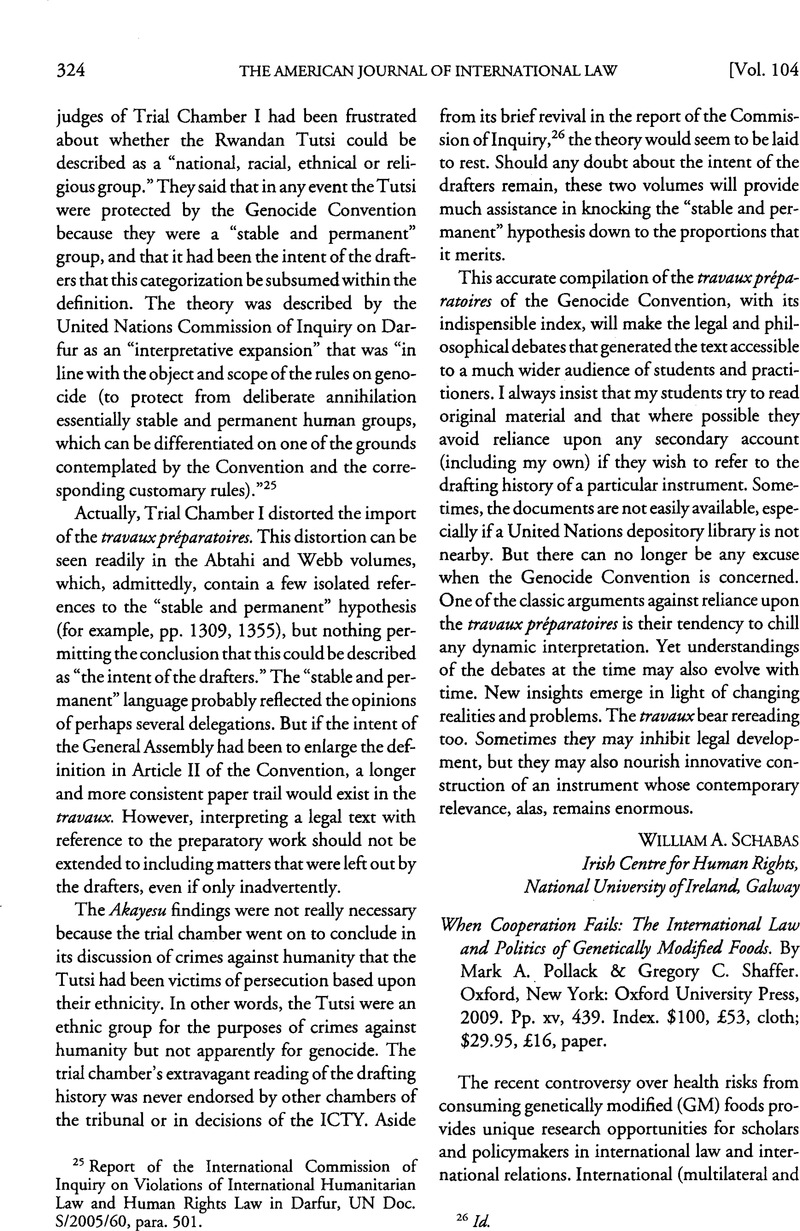No CrossRef data available.
Article contents
When Cooperation Fails: The International Law and Politics of Genetically Modified Foods. By Mark A. Pollack & Gregory C. Shaffer Oxford, New York: Oxford University Press, 2009. Pp. xv, 439. Index. $100, £53, cloth; $29.95, £16, paper.
Published online by Cambridge University Press: 27 February 2017
Abstract

- Type
- Recent Books on International Law
- Information
- Copyright
- Copyright © American Society of International Law 2010
References
1 See Antonia, Eliason Science Versus Law in WTO Jurisprudence: The (Misinterpretation of the Scientific Process and the (In) Sujficiency of Scientific Evidence in EC-Biotech , 41 N.Y.U. J. Int’l L. & Pol. 341, 374 (2009)Google Scholar.
2 Id. at 376.
3 Apr. 15, 1994, Marrakesh Agreement Establishing the World Trade Organization, Annex 1 A, in World Trade Organization, the Legal Texts: the “ Results of the Uruguay Round of Multilateral Trade Negotiations 59 (1999).Google Scholar
4 Citing Cass, Sunstein The Laws of Fear: Beyond the Precautionary Principle 25, 126 (2005).Google Scholar
5 Citing James, Boyle The Politics of Reason: Critical Legal Theory and Local Social Thought , 133 U. PA. L. Rev. 685, 751 (1985).Google Scholar
6 Regarding similar non-essentialist views, see Thomas, Bernauer Genes, Trade and Regulation: the Seeds of Conflict in Food Biotechnology (2003)Google Scholar, and Diahanna, Lynch and David, Vogel The Regulation of GMOs in Europe and the United States: A Case-Study of Contemporary European Regulatory Politics (2001), at http://www.cfr.org/publication/8688/regulation_of_gmos_in_europe_and_the_united_states.html.Google Scholar
7 Margaret, Levi A Model, a Method and a Map: Rational Choice in Comparative and Historical Analysis , in Comparative Politics: Rationality, Culture, and Structure 28 (Mark I. Lichbach, & Alan, S. Zucherman eds., 1997)Google Scholar (quoted at p. 78).
8 In both the 1998 Hormones decision, Appellate Body Report, European Communities—Measures Concerning Meat and Meat Products (Hormones), WT/DS26/AB/R (adopted Feb. 13, 1998) (reported by David Wirth at 92 AJIL 755 (1998)), modifying Panel Report, European Communities—Measures Concerning Meat and Meat Products (Hormones), WT/DS26/ R/USA (adopted Feb. 13, 1998), and the 2008 Hormones Suspension decision, Appellate Body Report, United States—Continued Suspension of Obligations in the EC-Hormones Dispute, WT/DS320/AB/R (adopted Nov. 14, 2008) (reported by Sungjoon Cho at 103 AJIL 299 (2009)), modifying Panel Report, United States—Continued Suspension of Obligations in the EC-Hormones Dispute, WT/DS320 (adopted Nov. 14, 2008), the panels sided with the U.S. position, whereas the Appellate Body struck down the panel reports, thereby moving toward the EU position.
9 Regarding an ardent advocate on the “management” model over the “enforcement” model, see Abram, Chayes & Antonia, Handler Chayes, the New Sovereignty: Compliance in The International Regulatory Agreements (1996).Google Scholar
10 In the transatlantic trade relations on the GM foods, the urge for control mostly originates from the U.S. industry interests to open up the closed EU market, as was evident in the EC-Biotech case. Yet such commercial considerations were also salient even in the transatlantic regulatory network/deliberation process. For example, as Pollack and Shaffer note, the Transatlantic Economic Partnership Biotech Group aimed to reduce unnecessary “trade barriers” (p. 104) through discussions and information exchange.
11 The authors also acknowledge the limits of WTO jurisprudence from both commercial and political perspectives.
12 Some scholars observe that the actual impact of the WTO panel decision might be “palpable” (p. 228, quoting Joanne, Scott The WTO Agreement on Sanitary and Phytosanitary Standards 128 (2007)).Google Scholar
13 Citing David, G. Victor The Sanitary and Phytosanitary Agreement of the World Trade Organization: An Assessment After Five Years , 32 N.Y.U. J. Int’l L. & Pol. 865, 933 (2004).Google Scholar
14 Frode, Veggeland & Svein Ole, Borgen Negotiating International Food Standards: The World Trade Organization ’s Impact on the Codex Alimentarius Commission , 18 Governance 675, 698 (2005)Google Scholar (discussing the “replication of WTO coalition [s] and positioning pattern [s] in the Codex”).
15 Pollack and Shaffer highlight the European Commission’s sophisticated efforts to defuse transatlantic tensions in the aftermath of the release of the WTO panel report in EC-Biotech. On the one hand, it responded positively to the concerns of the complainants (Canada and the United States) by, for example, pushing to approve the sale of certain GM crops that are commercially significant to Canada and the United States. On the other hand, it took a more modest approach to the “cultivation” of GM crops that EU members vehemently opposed. See Mark, Pollack & Gregory, Shaffer An Initial Response: Framing Biases and the Role of International Law in Dispute Management , Opinio Juris, Jan. 5, 2010, at http://opiniojuris.org/2010/01/05/an-initial-response-framing-biases-andthe-role-of-international-law-in-dispute-management/.Google Scholar
16 See James, S. Turner Delaney Lives! Reports of Delaney’s Death Are Greatly Exaggerated , 28 Envtl. L. Rep. 10, 003, 10, 018 (1998)Google Scholar. The Delaney Clause, somewhat revised since its initial statutory enactment in 1958, was the initial statement in U.S. law that no substance can be added to food if it causes cancer in humans or animals.




